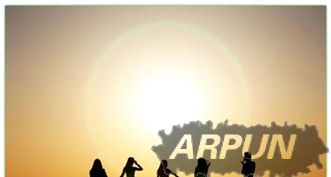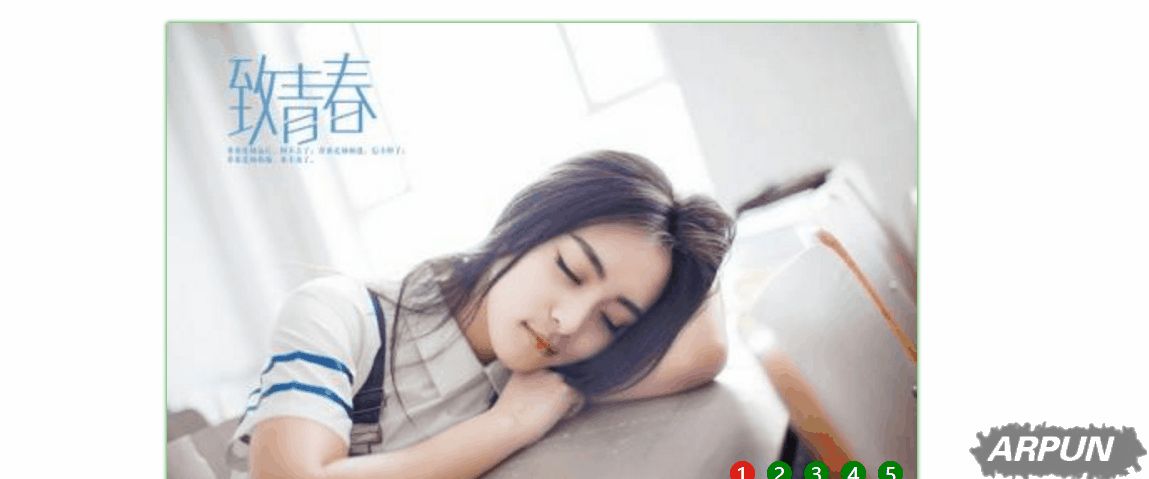原生js完成轮播图的示例代码
发表时间:2023-04-03 来源:明辉站整理相关软件相关文章人气:
[摘要]很多网站上都有轮播图, 但却很难找到一个系统讲解的, 因此这里做一个简单的介绍, 希望大家都能有所收获, 如果有哪些不正确的地方, 希望大家可以指出。 原理:将一些图片在一行中平铺, 然后计算偏移...
很多网站上都有轮播图, 但却很难找到一个系统讲解的, 因此这里做一个简单的介绍, 希望大家都能有所收获, 如果有哪些不正确的地方, 希望大家可以指出。
原理:
将一些图片在一行中平铺, 然后计算偏移量再利用定时器实现定时轮播。
步骤一:建立html基本布局
如下所示:
<!DOCTYPE html><html><head> <meta charset="UTF-8"> <title>轮播图</title></head><body> <div class="container"> <div class="wrap" style="left:-600px;"> <img class='lazy' data-original="./img/5.jpg" alt=""> <img class='lazy' data-original="./img/1.jpg" alt=""> <img class='lazy' data-original="./img/2.jpg" alt=""> <img class='lazy' data-original="./img/3.jpg" alt=""> <img class='lazy' data-original="./img/4.jpg" alt=""> <img class='lazy' data-original="./img/5.jpg" alt=""> <img class='lazy' data-original="./img/1.jpg" alt=""> </div> <div class="buttons"> <span>1</span> <span>2</span> <span>3</span> <span>4</span> <span>5</span> </div> <a href="javascript:;" rel="external nofollow" rel="external nofollow" rel="external nofollow" rel="external nofollow" class="arrow_left"><</a> <a href="javascript:;" rel="external nofollow" rel="external nofollow" rel="external nofollow" rel="external nofollow" class="arrow_right">></a> </div></body></html>
只有五张图片, 却使用7张来轮播, 这是为了实现无缝轮播, 后面会详细介绍。
而5个span, 即我们可以实时看到轮播图目前所处的位置。
最后是两个按钮, 可以通过它来控制前进与后退。
这里我们需要对wrap使用绝对定位, 所以用left:-600px;将第一张图片显示出来。
步骤二: css布局
首先, resetcss, 如下所示:
* { margin:0; padding:0; } a{ text-decoration: none; }接着, 我们为了让图片只在container中, 所以需要限定其宽度和高度并且使用overflow:hidden;将其余的图片隐藏起来, 并且我们希望wrap相对于container左右移动, 所以设置为relative, 如下:
.container { position: relative; width: 600px; height: 400px; margin:100px auto 0 auto; box-shadow: 0 0 5px green; overflow: hidden; } 我们设置wrap是绝对定位的, 所以,我们就可以通过控制Left和Right来控制图片的移动了。 设置z-index:1;以对后面将要放置的buttons作为参考。 因为共有七张图片, 所以width为4200px(每张图片我们设置为600X400),我们只需让图片左浮动即可实现占满一排了。
.wrap { position: absolute; width: 4200px; height: 400px; z-index: 1; }然后我们把图片设置位左浮动, 并限定其大小, 如下所示:
.container .wrap img { float: left; width: 600px; height: 400px; }现在的效果如下:

即这时已经显示出了第一张图片。 并且充满了整个container(container是有box-shadow的);
然后我们把显示次序的buttons放在图片的右下角。 并且设置z-index:2;以保证buttons是在图片的上面的。
.container .buttons { position: absolute; right: 150px; bottom:20px; width: 100px; height: 10px; z-index: 2; }然后将buttons下面的span做一个简单的修饰, 并且给和图片对应的span设置一个on类, 如下:
.container .buttons span { margin-left: 5px; display: inline-block; width: 20px; height: 20px; border-radius: 50%; background-color: green; text-align: center; color:white; cursor: pointer; } .container .buttons span.on{ background-color: red; }接下来, 我们把左右切换的箭头加上, 然后做简单的修饰, 注意:因为这里使用实体来表示左右箭头, 所以设置font-size才能改变其大小,
.container .arrow { position: absolute; top: 35%; color: green; padding:0px 14px; border-radius: 50%; font-size: 50px; z-index: 2; display: none; } .container .arrow_left { left: 10px; } .container .arrow_right { right: 10px; } .container:hover .arrow { display: block; } .container .arrow:hover { background-color: rgba(0,0,0,0.2); }步骤三:添加js逻辑
我们首先获取到 wrap(因为要设置其left才能控制轮播图), 然后获取到左右两个箭头, 并实现手动轮播, 如下:
var wrap = document.querySelector(".wrap"); var next = document.querySelector(".arrow_right"); var prev = document.querySelector(".arrow_left"); next.onclick = function () { next_pic(); } prev.onclick = function () { prev_pic(); } function next_pic () { var newLeft = parseInt(wrap.style.left)-600; wrap.style.left = newLeft + "px"; } function prev_pic () { var newLeft = parseInt(wrap.style.left)+600; wrap.style.left = newLeft + "px"; }值得注意的是, 这里wrap.style.left是一个字符串, 所以要转化为数字才能进行计算, 而设定left时就要加上px成为一个字符串了。
现在我们来测试一下:

可以看到, 在第一页时, left值为-600, 所以我们可以点击一次上一张, 但是当再点击一次时, 就出现了空白。 同样的, 下一张点击, 到-3600是最后一张, 就不能再继续点击了。
也就是说, 当我们点击下一张到-3600px(这是第一张图片)时, 我们需要下次跳转到第二张, 即-1200px;这样才能正常跳转;
同理, 当我们点击上一张到0px(这是第五张图片时), 我们希望下次跳转到第四张, 即-2400px;
按照这样的思路我们重新将next_pic和prev_pic函数修改如下:
function next_pic () { var newLeft; if(wrap.style.left === "-3600px"){ newLeft = -1200; }else{ newLeft = parseInt(wrap.style.left)-600; } wrap.style.left = newLeft + "px"; } function prev_pic () { var newLeft; if(wrap.style.left === "0px"){ newLeft = -2400; }else{ newLeft = parseInt(wrap.style.left)+600; } wrap.style.left = newLeft + "px"; }这时, 我们就可以发现图片可以循环播放了!
但是, 这时我们仅仅时手动循环播放的, 我们如果希望自动播放, 使用setInterval()即可, 如下所示:
var timer = null; function autoPlay () { timer = setInterval(function () { next_pic(); },1000); } autoPlay();即先设定一个计时器, 然后创建一个可以自动播放的函数, 最后调用这个函数即可。 现在它就可以自动播放了, 效果如下:

但是如果我们想要仔细看其中一个图片的时候, 我们希望轮播图停止播放, 只要clearInterval()即可, 如下:
var container = document.querySelector(".container"); container.onmouseenter = function () { clearInterval(timer); } container.onmouseleave = function () { autoPlay(); }现在, 只要我们把鼠标移入轮播图中, 这时轮播图就不会播放了。 而移开鼠标之后, 轮播图自动播放。
但是到目前为止, 轮播图下方的小圆点还没有动, 现在我们就实现它。
原理很简单, 即设置buttons的index初始值为0, 即第一个span的class为on, 然后触发next_pic函数时, index加1, 当触发prev_pic函数时, inex减1, 并设置当前index的小圆点的class为on, 这就要求index必须设置为全局变量, 才能保证它在每一个函数的作用域中。
添加showCurrentDot函数:
var index = 0; var dots = document.getElementsByTagName("span"); function showCurrentDot () { for(var i = 0, len = dots.length; i < len; i++){ dots[i].className = ""; } dots[index].className = "on"; }在next_pic中添加代码:
index++; if(index > 4){ index = 0; }在prev_pic中添加大吗:
index--; if(index < 0){ index = 4; } showCurrentDot();这样, 轮播图就可以自动切换, 并且小圆点也在随着图片的变化而变化了。
但是, 这距离我们经常看到的轮播图还有一定距离 - - - 当点击小圆点时, 就可跳转到相应图片。 实现原理即: 点击小圆点, 就使wrap的Left变成相应的值。 代码如下:
for (var i = 0, len = dots.length; i < len; i++){ (function(i){ dots[i].onclick = function () { var dis = index - i; if(index == 4 && parseInt(wrap.style.left)!==-3000){ dis = dis - 5; } //和使用prev和next相同, 在最开始的照片5和最终的照片1在使用时会出现问题, 导致符号和位数的出错, 做相应地处理即可 if(index == 0 && parseInt(wrap.style.left)!== -600){ dis = 5 + dis; } wrap.style.left = (parseInt(wrap.style.left) + dis * 600)+"px"; index = i; showCurrentDot(); } })(i); }原理就是当点击到小圆点时, 得到相应的i值, 这个i值也就是span的index值, 我们拿他和全局变量index作比较, 然后重新设置wrap.style.left的值, 然后把i值复制给全局变量index, 最后显示当前的小原点即可。 值得注意的是:这里涉及到了闭包的概念, 如果直接使用for循环, 则不能得到正确的结果。
最终效果如图:

最终代码如下所示:
<!DOCTYPE html><html><head> <meta charset="UTF-8"> <title>轮播图</title> <style> * { margin:0; padding:0; } a{ text-decoration: none; } .container { position: relative; width: 600px; height: 400px; margin:100px auto 0 auto; box-shadow: 0 0 5px green; overflow: hidden; } .container .wrap { position: absolute; width: 4200px; height: 400px; z-index: 1; } .container .wrap img { float: left; width: 600px; height: 400px; } .container .buttons { position: absolute; right: 5px; bottom:40px; width: 150px; height: 10px; z-index: 2; } .container .buttons span { margin-left: 5px; display: inline-block; width: 20px; height: 20px; border-radius: 50%; background-color: green; text-align: center; color:white; cursor: pointer; } .container .buttons span.on{ background-color: red; } .container .arrow { position: absolute; top: 35%; color: green; padding:0px 14px; border-radius: 50%; font-size: 50px; z-index: 2; display: none; } .container .arrow_left { left: 10px; } .container .arrow_right { right: 10px; } .container:hover .arrow { display: block; } .container .arrow:hover { background-color: rgba(0,0,0,0.2); } </style></head><body> <div class="container"> <div class="wrap" style="left: -600px;"> <img class='lazy' data-original="./img/5.jpg" alt=""> <img class='lazy' data-original="./img/1.jpg" alt=""> <img class='lazy' data-original="./img/2.jpg" alt=""> <img class='lazy' data-original="./img/3.jpg" alt=""> <img class='lazy' data-original="./img/4.jpg" alt=""> <img class='lazy' data-original="./img/5.jpg" alt=""> <img class='lazy' data-original="./img/1.jpg" alt=""> </div> <div class="buttons"> <span class="on">1</span> <span>2</span> <span>3</span> <span>4</span> <span>5</span> </div> <a href="javascript:;" rel="external nofollow" rel="external nofollow" rel="external nofollow" rel="external nofollow" class="arrow arrow_left"><</a> <a href="javascript:;" rel="external nofollow" rel="external nofollow" rel="external nofollow" rel="external nofollow" class="arrow arrow_right">></a> </div> <script> var wrap = document.querySelector(".wrap"); var next = document.querySelector(".arrow_right"); var prev = document.querySelector(".arrow_left"); next.onclick = function () { next_pic(); } prev.onclick = function () { prev_pic(); } function next_pic () { index++; if(index > 4){ index = 0; } showCurrentDot(); var newLeft; if(wrap.style.left === "-3600px"){ newLeft = -1200; }else{ newLeft = parseInt(wrap.style.left)-600; } wrap.style.left = newLeft + "px"; } function prev_pic () { index--; if(index < 0){ index = 4; } showCurrentDot(); var newLeft; if(wrap.style.left === "0px"){ newLeft = -2400; }else{ newLeft = parseInt(wrap.style.left)+600; } wrap.style.left = newLeft + "px"; } var timer = null; function autoPlay () { timer = setInterval(function () { next_pic(); },2000); } autoPlay(); var container = document.querySelector(".container"); container.onmouseenter = function () { clearInterval(timer); } container.onmouseleave = function () { autoPlay(); } var index = 0; var dots = document.getElementsByTagName("span"); function showCurrentDot () { for(var i = 0, len = dots.length; i < len; i++){ dots[i].className = ""; } dots[index].className = "on"; } for (var i = 0, len = dots.length; i < len; i++){ (function(i){ dots[i].onclick = function () { var dis = index - i; if(index == 4 && parseInt(wrap.style.left)!==-3000){ dis = dis - 5; } //和使用prev和next相同, 在最开始的照片5和最终的照片1在使用时会出现问题, 导致符号和位数的出错, 做相应地处理即可 if(index == 0 && parseInt(wrap.style.left)!== -600){ dis = 5 + dis; } wrap.style.left = (parseInt(wrap.style.left) + dis * 600)+"px"; index = i; showCurrentDot(); } })(i); } </script></body></html> 总结:
实现一个轮播图还是不难的, 大体思路: 先创建一个div, 限定其宽度和高度, overflow:hidden。 然后创建一个装图片的div, 宽度为所有图片的总宽度, 并且使其浮动, 这样所有的图片就处于一行中。 然后为了实现无缝滚动, 所以需要在首尾分别添加一张过渡图片。 先添加两个按钮, 使其可以手动轮播, 然后只需要添加一个定时器使其朝一个方向自动轮播即可, 因为用户有时需要查看详情, 所以当鼠标进入时就clear定时器, 滑出再定时播放。 为了更好地用户体验, 我们再下面添加了一排小圆点, 用户可以清楚地知道现在所处的位置, 最后, 利用闭包使得用户可以直接通过点击小圆点切换图片。
网站建设是一个广义的术语,涵盖了许多不同的技能和学科中所使用的生产和维护的网站。





